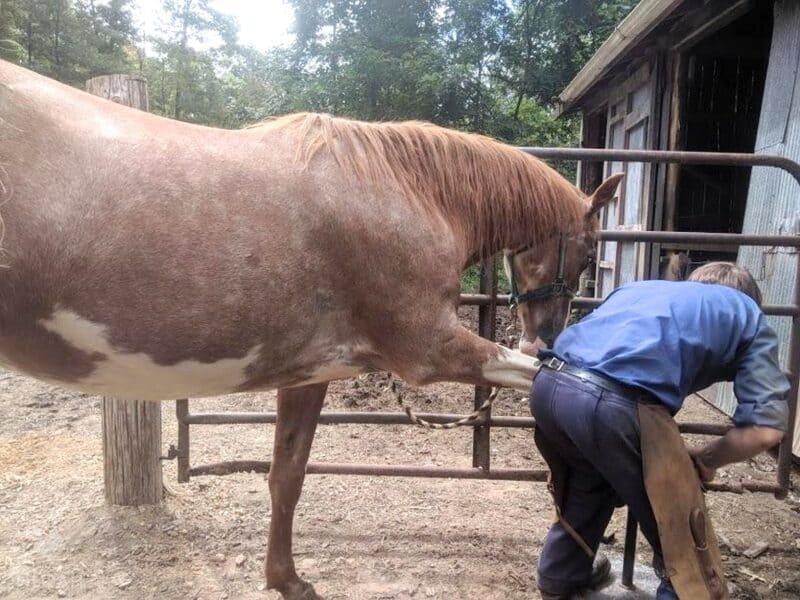No matter where you find horses in the company of people these days, chances are very high that those horses will be wearing horseshoes on their hooves.
Horseshoes allow horses better traction on some surfaces and also protect their hooves from impact.

But most shoes are nailed directly on the hoof itself. This raises an obvious question… Do horseshoes actually hurt horses?
No, fitting and wearing horseshoes will not harm horses so long as they are fitted and maintained properly. Improperly fitted or neglected shoes may cause discomfort, accidents and injuries, however.
Generally, shoeing a horse is a good idea and is painless for the horse if done by a skilled farrier.
But not all horses need shoes and the shoeing process does not always go smoothly. Injuries and other issues are, sadly, not unheard of.
Learn more about the process of shoeing a horse, when and why you should shoe horses and a lot more below.
What is a Horseshoe, Exactly?
Even if you don’t know one single thing about horses, it is all but certain that you know what a horseshoe is, or at least what it looks like.
A traditional horseshoe consists of a semicircular metal plate that is nailed to the bottom of the horse’s hoof.
It protects the hoof from impact on hard surfaces and also allows for better traction when operating on unstable or soft surfaces.
Although the vast majority of horseshoes are the ubiquitous metal kind described above, many others exist.
Modern horseshoes have become quite sophisticated over time, with some models featuring synthetic materials for lighter weight, or rubber for shock absorption and enhanced traction on concrete or asphalt.
Do All Horses Need Horseshoes?
No. Whether or not a horse needs horseshoes depends on the horse, its environment and its activities.
Some horses never need shoes: horses that live mostly on dirt or other soft ground and aren’t made to work hard jobs or race can probably go most of their lives without needing shoes.
But most horses need or will benefit from horseshoes.
Why Should Horses Wear Shoes?
There are several reasons why a horse might need to wear horseshoes.
Horses that race on hard surfaces, such as track racing, exercise or show jumping require shoes for better traction and protection from the hard surface of the track.
Working horses often require shoes due to their heavier workloads and because some work environments, such as rocky terrain, require extra protection for the hoof.
In short, if your horse is used for sport or labor, shoes might be needed even on soft ground since they will protect the hoof from accelerated wear.
Do All Horseshoes Need to Be Nailed On?
Surprisingly, no! Horseshoes can be attached using special glues and adhesives. Typically shoes of this type are specially manufactured for this form of attachment.
Other non-nailed options are also available, such as plastic boots that are fitted to the hoof and then secured with adhesive or Velcro, and even individual studs or spikes that can be glued or screwed into the hoof.
Although the typical, classic horseshoe works well for many applications and is still nailed on, it isn’t the only way to do things.
How Can Horseshoes Hurt a Horse?
One of the most common issues with horseshoes is that they can cause discomfort or even injury to a horse if improperly fitted or poorly maintained.
This can include anything from ill-fitting shoes that rub and chafe the hoof wall, to nails that penetrate too deeply into the sensitive parts of the foot.
A loose horseshoe can also be dangerous as it can easily come off, leaving the horse unprotected or causing a trip or fall.
And if a shoe is too tight, it can put abnormal pressure on the foot and induce injuries inside the foot.
Some horses also have special challenges due to their conformation, hoof structure or underlying medical conditions which might require special types of horseshoes or regular changes to accommodate their issues.
How to Figure Out if Your Horse Needs Horseshoes
Generally, yes, shoeing your horses is rarely a bad idea.
However, if your horses are not used for activities that require specialized traction or protection, and if they don’t regularly walk or gallop on hard ground, then it is best to assess the situation and determine whether shoeing is truly necessary.
Often this can be done simply by examining your horse’s hooves regularly to check for wear and overall condition.
If you notice any cracking, peeling or other signs of damage, then horseshoes may be necessary to protect the hoof from further injury.
In addition, you should also watch for any signs of lameness or discomfort when your horse is in motion, as this can indicate pain that may also show a need for horseshoes.
Your veterinarian or farrier will be able to provide more specialized advice on whether shoeing is necessary.
Tom has lived and worked on farms and homesteads from the Carolinas to Kentucky and beyond. He is passionate about helping people prepare for tough times by embracing lifestyles of self-sufficiency.
